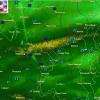-
Posts
2,984 -
Joined
-
Last visited
Content Type
Profiles
Blogs
Forums
American Weather
Media Demo
Store
Gallery
Everything posted by high risk
-
The wind threat is behind the cold front. Still several hours away for the I-95 corridor
-
Oh good. You’re back with your incessant 3rd grade understanding of NWP.
-
I think it's legit. The forecast soundings show potential for good mixing behind the front, and there will be some strong speeds just above the surface.
-
Several CAMs take most of us into the low 60s Sunday, with the NAM Nest being a notable holdout. Soundings support possible thunder ahead of the cold front.
-
As expected. The changes between the 06Z and 12Z GEFS were small, and both the 13 and 19Z NBM use the same cycle (00Z) of the EMCWF ensemble.
-
It ran on time, but they are having huge issues with getting the data to their customers, so no site is able to generate any graphics.
-
Of course the model ran. The problems are with the dissemination of the output.
-
But you're showing the parent (12 km), and I praised the nest (3 km). The parent NAM is not a very good model, but the nest is, especially at shorter ranges. I don't trust the synoptics much beyond 36 hours.
-
In seriousness, though, the HRRR was developed to be a model to assist with forecasting of deep convection. Is it totally useless in winter? Of course not, and we know that it led the way on lower QPF last Saturday, but at least be suspicious when it bucks most other guidance. Go back and look at simulated reflectivity from yesterday’s 12Z NAM Nest. Pretty damn good. This is one of the first models I look at for short-term winter forecasts. Too bad that its days are numbered.
-
New HRRR and NAM Nest runs have the late afternoon precip starting as snow or sleet for areas northern and central areas (before quickly turning to rain).
-
When looking at the NAM Nest (3 km), the snow product that is truest to the actual internal model microphysics is the Ferrier accumulation. It does, however, tend to run slightly low, so I like mentally blending it with the 10:1 product.
-
The snow depth product is notably less than 1/2 of those amounts. That product isn't the gospel by any means, but when the discrepancy between the snowfall and snow depth maps is that large, that tells me that the model really isn't producing the big snow totals suggested by those maps.
-
NAM parent vs. nest timing is still the difference between whether Maryland schools can open tomorrow (and dismiss early) or have to be closed for the day.
-
No guarantees, but that's a likely sign that the 00Z GFS will end up with the heaviest south of DC as well.
-
That's what I had been thinking, but the NAMs would accumulate earlier. The parent would accumulate by early afternoon; the nest at least wouldn't start accumulating until 3-4pm or so, at least on the MD side of the river.
-
The QPF/snow may come out similar, but at least from a school closing perspective, the 3 km NAM is notably slower with the arrival than the parent.
-
I totally get the frustration, and the guidance Thursday and Friday wasn't good, but several of us here pointed out last night that the 00Z CAMs had backed way off on the precip. With a delayed start and weaker event, we were inevitably going to warm up and significantly lessen any possible impacts. The problem is that once the advisories are hoisted, local WFOs are understandably super hesitant to pull them back.
-
You can't really define a range for it, as it is combining forecasts from multiple ensemble systems with some extra adjustments made with bias correction techniques for amounts (not spatial coverage). Ultimately, it only has much accuracy as the overall synoptic skill and skill-spread ratios of the various inputs, but its purpose is that it's not as prone to wild swings from individual solutions. That said, the "deterministic" solution shown in that previous post is worth looking at, but it should be done in conjunction with percentiles and probabilities.
-
The HRRR isn't alone with being stingy on the precip. Several of the evening CAMs show the same idea.
-
A couple of important points, from a model perspective: - The only modeling system that actually tracks and accumulates freezing rain every model time step is RAP/HRRR - For all other models, the various sites are making assumptions that the forecasted precip type on the hour applies to the entire hour. This is ok if they have hourly output from the model, but if it's 3-hourly (or even less frequent), it's pretty inaccurate - For most of the U.S. models, the precip type output shows freezing rain if the falling hydrometeors are rain, and the skin temp is at or below 32. So, the plots of "accumulated freezing rain" are tallying ice the same whether it's 31.9 or 26 - The FRAM stuff is better, but it's very much tied to rates and wind, and in my mind, it accumulates too generously when temps are marginal. - ZR at 31 degrees is very different if it's been in the 20s and temps are rising as opposed to being in the mid 30's with falling temps. None of these ZR products really account for that. So, even if you see big amounts of freezing rain on maps for the areas around DC, it's critical to assess the temperature trends. With temps in the mid 30s during the day falling to 31 or 32, I'm really skeptical about icing potential. The precip falling at night probably helps a bit, and maybe an initial burst of sleet cools surfaces enough, but the overall setup argues for the real icing potential to be well north and northwest of the city.
- 498 replies
-
- 14
-

-

-
NAM camp seems to be coming around to the idea of a later start too.
-
That's a weird evolution in the HiResW FV3, but thanks for pointing that out.
-
Is there any model other than the RGEM bring precip to most of the area during daylight hours on Wednesday? I know that several CAMs have that lead snow band in northeast MD, but it seems like a lot of guidance is dry for most of us until the tail end of the evening commute.
-
12Z NAM ptype and soundings suggest an initial shot of snow followed by a longer period of sleet. It eventually goes to rain or freezing rain but with very marginal surface temperatures until you get closer to the MD-PA border.
-
Still looks like one batch of rain during the midday and another this evening.






